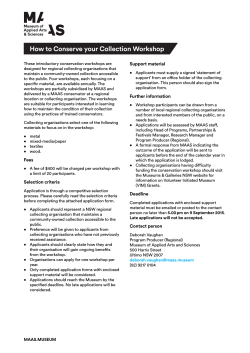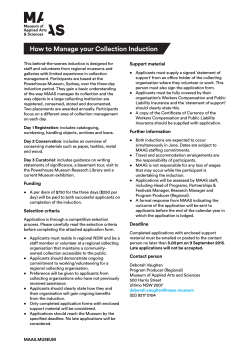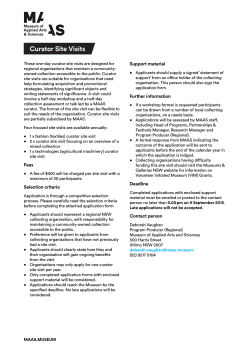
Museums Australia Thinker1 Poster
M y students had never programmed before, but with the Thinker1 they were controlling the LEDs and the buzzer in just a few minutes. It is a great way to introduce students to the internet of things. James Oliver Peter Mahony Year 9 DesignTech Teacher, After students completed a Thinkspace Thinker1 session Thinker1 Mark II 1 2 3 5 4 Original Prototype Thinker1 Mark I Learning material Thinker1 Mark II Thinker Shield Designed to remove the need for a breadboard normally used with Arduino microcontrollers. Built in house at MAAS with the prototype going with several redesigns to suit education market. Over 500 of the Thinker1 boards were made with the majority ending up in the hands of young learners of MAAS holiday programs Learning material designed to ensure end users can continue to code with the Thinker1 without educator help. Materials provided free on museum website. The board was redesigned to include additional features such as keyboard emulation. Research showed additional functionality made it less user friendly. In partnership with Freetronics the board was turned into a shield capable of extending the functionality of any standard Arduino board. The Thinker1 Transforming electronics education T hinker1 was designed at the Museum of Applied Arts and Sciences to fill an educational need in physical computing. It is made up of a unique blend of on-board components and can also be easily expanded using standard Arduino compatible components. Often in the classroom when physical computing is taught it requires a circuit to be created and then connected to the board before you can even start coding the microcontroller. The Thinker1 eliminates this complicated setup and allows students to get outcomes quickly. It is easy to setup and works on Mac, PC and Linux. This allows learners of ages 9 and up to code in a professional language. Within 30 minutes learners are able to control, using the Arduino language based on C, a row of LEDs. At the end of a full day workshop learners are able to write music with the buzzer and created persistence of vision activities with the LEDs. The learning materials have been refined over time based on real classroom experiences. It has been used in schools, at home, workshops, drop-in sessions and teacher professional development. Based on feedback, activities have been refined to have less steps and have more powerful outcomes. Not only have the learning materials been updated over time but the actual hardware configuration has been adapted. The initial board was stand alone and included a dedicated microcontroller. The design being mass produced is a shield which is compatible with any Arduino board with a standard header setup. The Thinker1 Shield, known as the ThinkerShield, opens up physical computing to an even wider age range. It can be programmed from visual programming languages such as Scratch and TouchDevelop. The biggest problem MAAS has had with the development process has been struggling to meet the demand of teachers who would like a set of the boards for their own classroom after completing a workshop in the museum. Learning Materials The learning materials are all freely available from the museum website. They are designed to allow a parent with no knowledge to assit their child. All activies have an outcome in 6 steps or less! Classroom tested The Thinker1 has been used in both school and holiday workshops at MAAS for the last 2 years. It has become part of maker spaces in classes and is in schools in 3 different states. For further information visit our Thinkspace site via the learn section of the MAAS site: maas.museum/learn The ThinkerShield is the consumer version of the Thinker1. It extends the features of the Thinker1 to allow learners to connect additional components using alligator clips. It is fully compatible with the existing Thinker1 code. New learning materials are being developed in preparation for entry into the wider market. It is an ideal first step into physical computing for any age from 7 to adult. Expandable Learners once they have mastered the onboard components can add additional components via the breakout headers. In this example a learner controls a Minecraft character using the Thinker1. Learn@maas.museum
© Copyright 2025
















